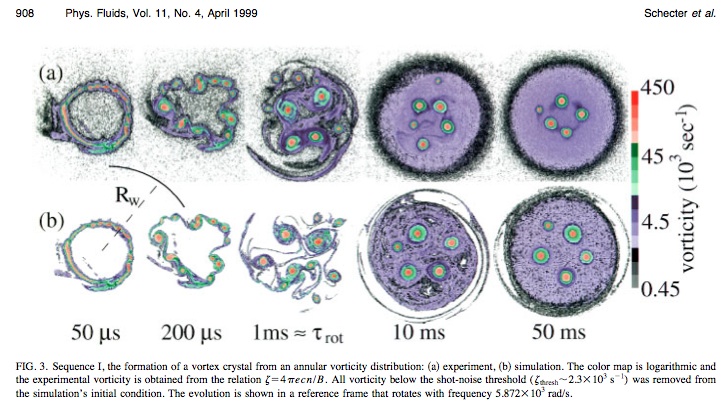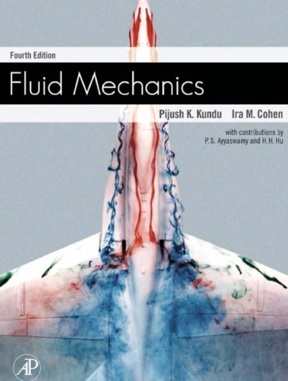|
Syllubus
|
This Web Site is a basic resource for APPH 4200. Copies of my lecture notes will be available for download in Adobe PDF formats.
A preliminary lecture plan is llisted below. I anticipate changes as we move along. Some topics may require more lecture time, and some will require less. Depending on your interests and comments, we may change some of the topics in the last third of the course.
| Lecture Dates |
Topics |
| Sept 5, 10,12 |
Introduction to Fluids.
Mathematical Preliminaries: Cartesian tensors.
Chapters 1 and 2
Lecture 1 Notes
See discussion about lift generated by fluid flow around a rotating cylinder at NASA's Glenn Research Center.
Lecture 2a Notes
Lecture 2b Notes
Download useful vector identities (and plasma and hydro info)
Naval Research Lab's Plasma Formulary.
In class problem (Sept 10): Fluid Circulation around a Cylinder
In class problem (Sept 12): Vector Calculus Identities |
Sept 17
(No Class Wed 9/19) |
Mathematical Preliminaries: Cartesian tensors.
Chapter 2
Lecture 3 Notes
Fluids in the news (9-2-2014): Soliton Turbulence seen for the first time on North Carolina’s Coast. See "Soliton Turbulence in Shallow Water Ocean Surface Waves," PRL, 113, 108501. By Andre Costa, a PhD student at Aix-Marseille Université, France.
Fluids in the news (9-10-2018): "Leidenfrost wheels," Nature Physics (2018) Beautiful movies illustrating "particle image velocometry (PIV); see supplemental materials.
Basic kinematics: Lagrangian vs. Eulerian,
Streamlines & trajectories, total derivative,
Mass continuity.
Chapter 3
Lecture 4 Notes
In class problem (Sept 17): Axisymmetric steady compressible flow |
| Sept 24, 26 |
Derivation of Navier-Stokes equation.
Balance of forces. Bernoulli's Equation.
Stress and strain tensors, definition of a Newtonian fluid.
Effects of a rotating reference frame.
Chapter 4
Lecture 5 Notes
Lecture 6 Notes
Excellent video about Eulerian and Lagrangian Descriptions of Fluids (by Prof. John Lumley, Penn State, 1962). Part 2 is located here. The mathematics is very well explained in Part 2. Finally, Part 3 illustrates a more general vector field and the acceleration of a material element of a fluid.
Read about the Clay Mathematics Institute's Navier-Stokes $1,000,000 challenge at this link. |
| Oct 1, 3 |
Fluids in the news:
Using the conservation equations…
Chapter 4
Lecture 7 Notes |
| Oct 8, 10 |
Vorticity
Chapter 5
Lecture 8 Notes
Fluid Video Gallery from Melbourne, AU, with colliding vortex rings.

See wonderful work by UCSD Pure Electron Plasma Group, including "Vortex crystals from 2D Euler flow: Experiment and simulation", Phys. Fluids, 11(4) 905 (April 1999) and an early news article in Science highlighting both Columbia and the UCSD plasma research.
"Anatomy of a Bathtub Vortex," by A. Andersen and co-authors, Physical Review Letters, Vol. 91, p. 104502 (2003).
More Chapter 5
Lecture 9 Notes
Excellent Vorticity videos from the 1960's Fluid Mechanics Films series. See Vorticity Part 1 and Vorticity Part 2. |
Oct 15 Cancelled
Oct 17 |
Simple calculations of 2D motion of line vortices. Mathematica notebook is here Line Vorticies.nb. A video is here ring_vortex.mp4
Potential flow theory.
Irrotational flow.
Potential flow around obstacles: lift and drag.
Chapter 6
Lecture 10 Notes
Link to "complex analysis" at Wolfram's MathWorld.
Mathworld's page on Cauchy-Riemann Equations.
Nice biography of Paul Richard Heinrich Blasius (1883-1970).
Lecture 11 Notes (Ch. 6)
Numerical example prepared using Mathematica. Mathematica is available in all Columbia University computer labs, and a student license is available.
Mathematica notebook and print-out in pdf. |
| Oct 22 |
Dimensional analysis, similarity. Good overview: "Dynamic similarity, the dimensionless science," by Bolster, Hershberger, and Donnelly, Physics Today, Sept, 2011.
Reynolds number.
Laminar boundary-layer theory, drag on thin flat plate.
Chapter 9
Lecture 12 Notes (Ch. 8 & 9)
Lecture 13 Notes (Ch. 9)
Lecture 15 Notes (Midterm Review) |
Wednesday
Oct 24 |
MIDTERM
(Appendecies and Equations attached to exam: here.)
Results are summarized here. |
Cancelled Oct 29
Oct 31 |
More Chapter 9...
Lecture 14 Notes (More Ch. 9) Waves
Vortex Sheading Video (a great student project, entertaining to watch) |
| Nov 5, 7 |
APS Division of Plasma Physics Meeting (New Orleans). Classes cancelled. |
| Nov 6 |
Election Day Break |
| Nov 12, 14 |
More waves....
Lecture 16 Notes (Ch. 7, Surface Gravity Waves)
Lecture 17 Notes (Ch. 7, Internal Gravity Waves)
Outstanding Physical Oceanography Lab Demos from Univ Rhode Island
Linear surface gravity waves. Continuously stratified flow.
Shallow and deep water equations. |
| Nov 19, 21 |
Fluids in the news (11-2014): Viscoelasticity Breaks the Symmetry of Impacting Jets
Lecture 18 Notes (Ch. 7, Capillary Waves & Sound)
Lecture 18 (more) Notes (Tides and Stellar Clouds)
Linear Instability; Benard Thermal Instability; Kelvin-Helmholtz problem:
stability of a sheared flow with stable density stratification.
Chapter 12
Lecture 19 Notes
Mathematica notebook and print-out in pdf. |
| Nov 22-23 |
Thanksgiving Holiday |
| Nov 26, 28 |
Lecture 20 Notes Rotating and parallel shear flows (Chapter 12)
"Transport of solar wind into Earth's magnetosphere through rolled-up Kelvin-Helmholtz vortices", Hasegawa, et al., Nature, 430, 755 (2004).
Three relevant articles reviewing viscous dynamics:
Chapter 10: Ludwig Prandtl and viscous boundary layer
Lecture 22 Notes (Ch. 10)
(Mathematica Notebook and PDF file of numerical solution to boundary layer.)
Nice biographies of Ludwig Prandtl (1875-1953) and also of his graduate student, Paul Richard Heinrich Blasius (1883-1970). |
| Dec 3, 5 |
Chapter 13: Introduction to turbulence
Lecture 21 Notes
(Lorenz Model Mathematica Notebook and PDF file.)
Lorenz Model at Wikipedia Site.
Movie of Turbulent Fluid Mixing from Prof. Thomas Peacock at MIT.
Chapter 14 Geostrophic and quasi-geostrophic flow.
Lecture 23 Notes
UNISYS Weather site and atmospheric vorticity and flow maps.
Biography of Carl-Gustaf Rossby at American Meteorological Society.
Time magazine's cover story about Rossby and weather forecasting.
Biography of Jule Charney at AGU.
Good review of Rossby waves by Robert Dickinson (Annual Review of Fluid Mechanics, vol 10, 1978)
Rossby waves in oceans, Chelton and Schlax,Science, 1996.
Rossby waves on the sun, Kuhn, et al., Nature, 2000.
Biography of Jack Bjerknes. |
| Dec 10 |
Lecture 24 Notes Review for final exam. |
T.B.D.
|
FINAL EXAM |
|

